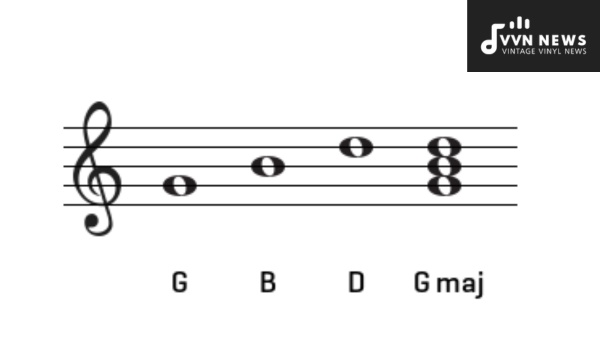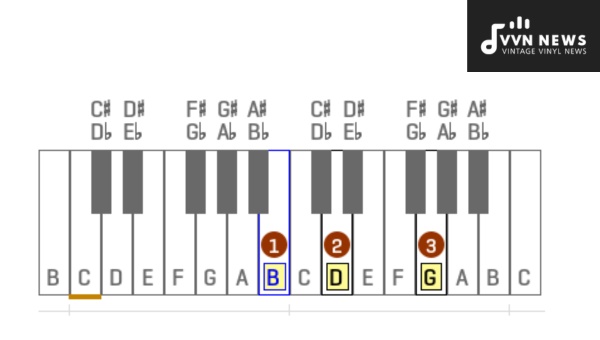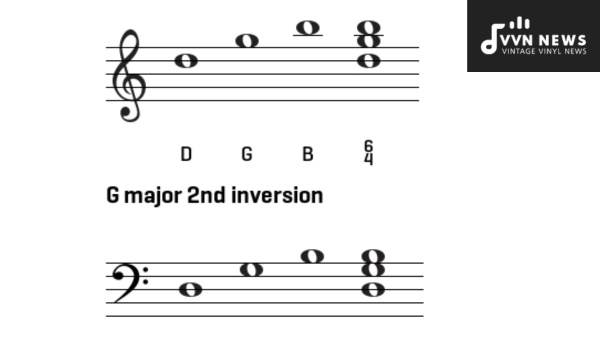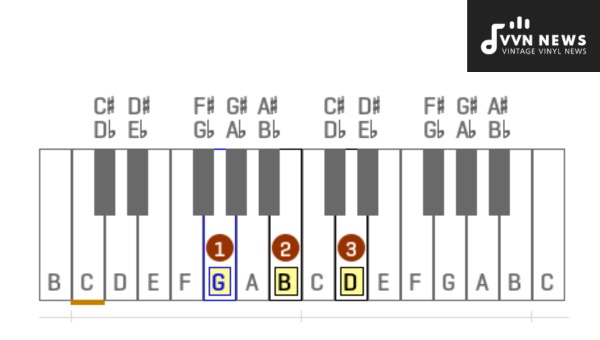As a musician, I always find it fascinating how something as simple as three notes can create such beautiful harmony.
Today, I want to share with you my insights on the G Major Triad – a fundamental and widely used chord in Western music.
Whether you’re a seasoned musician or just starting to explore the world of music theory, understanding the G Major Triad will enhance your understanding of chords and help you unlock new creative possibilities in your compositions.
So, let’s dive into this essential musical structure and explore its components in detail.
What is the G Major Triad?
The G Major Triad is a three-note chord that is widely used in Western music. It consists of the notes G, B, and D, creating a sound that represents the major tonality associated with G. The G Major Triad serves as the foundation for many popular songs and can be found across various genres and styles. Understanding this chord is crucial for musicians as it forms the basis for understanding chord progressions and harmonies. By comprehending the structure and sound of the G Major Triad, you will be equipped to create captivating melodies and compositions.
How is the G Major Triad constructed?

The G Major Triad consists of three notes: G, B, and D. These notes are stacked on top of each other in a specific pattern to create the chord.
- The root note of the G Major Triad is G. It serves as the foundation of the chord and gives it its name.
- The third of the triad is B. It is two steps higher than the root note on the musical scale.
- The fifth note is D. It is four steps higher than the root note on the scale.
Combining these three notes – G, B, and D – creates a harmonious sound that represents the major tonality associated with G.
In music theory terms, this triad follows a specific pattern known as a major third (the interval between G and B) followed by a minor third (the interval between B and D). This pattern results in a chord that sounds stable and lively at the same time.
Also Read: D Major Chords [Unlock The Power Of Your Guitar]
Why is the G Major Triad crucial?
The G Major Triad holds immense importance in music theory and composition. Here are some key reasons why this chord is crucial:
- Foundation of Western Music: The G Major Triad is one of the primary chords in Western music, making it essential for understanding harmony and chord progressions. It serves as a common point of reference for musicians.
- Major Tonality: The G Major Triad represents the major tonality associated with the key of G. It has a bright and uplifting sound, commonly used to convey positive emotions in music.
- Versatility: The G Major Triad can be used in a variety of musical genres, including pop, rock, country, and jazz. Its versatility allows it to fit seamlessly into different styles and compositions.
- Chord Progressions: Understanding the function of the G Major Triad within chord progressions is crucial for creating cohesive songs. It often acts as the tonic (home) chord or serves as a stepping stone to other chords in a progression.
- Melody Creation: The notes within the G Major Triad provide a solid foundation for melody creation. By using these notes as reference points, composers can build melodic lines that harmonize naturally with the chord.
- Transposition: Transposing music into different keys is made easier when one understands how triads work within different tonalities. Knowing the structure and sound of the G Major Triad makes it simpler to adapt compositions to other keys.
Grasping the concepts surrounding the G Major Triad enhances your ability to analyze music, compose original pieces, improvise solos, and understand chord progressions across various musical genres.
How can you play the G Major Triad across various instruments?
Whether you’re a guitarist, pianist, or even a ukulele player, understanding how to play the G Major Triad on your instrument is essential. Here’s a breakdown of how to play the G Major Triad on some common instruments:
Guitar:
- To play the G Major Triad on the guitar, you can start with the open G string as your root note.
- Place your index finger on the second fret of the A string, which is the note B.
- Then, place your middle finger on the third fret of the low E string, which is another G.
- Finally, place your ring finger on the third fret of the B string, which is D.
- Strum these three strings together to create a rich and vibrant G Major sound.
Piano:
- On a piano keyboard, locate the white key that corresponds to G. This will be your root note.
- Skip one white key and press down on B (the next white key after G).
- Skip another white key and press down on D (the next white key after B).
- Play these three keys simultaneously or in succession using your right hand to create a beautiful G Major Triad.
Also Read: G Major Scales And Chords [Expand Your Musical Understandings]
Ukulele:
- To play the G Major Triad on a ukulele, start by placing your index finger on the second fret of the C string. This is your root note.
- Next, place your middle finger on the fourth fret of the E string, which is another G.
- Finally, place your ring finger on the fifth fret of the A string, which is D.
- Strum all three strings together or pluck them individually to produce a melodic and harmonious G Major sound.
No matter what instrument you play, mastering various chord shapes and inversions will expand your musical capabilities. Practice playing different voicings of the G Major Triad on your instrument to develop a broader understanding of chord progressions and create unique sounds within your music.
What inversions exist for the G Major Triad?

In music theory, an inversion refers to rearranging the order of the notes within a chord. In the case of the G Major Triad, there are three inversions that can be created by moving the lowest (or bass) note of the chord to a higher position.
The first inversion is known as the G Major Triad in first inversion. It is created by moving the G (root note) to an octave above. In this inversion, the notes are arranged in this order: B-D-G.
The second inversion is called the G Major Triad in second inversion. Here, we move the B (third) to an octave above. This results in the notes D-G-B.
The root position or fundamental form of the G Major Triad, where no notes are moved and it retains its original structure: G-B-D.
These inversions allows you to create smooth and transitioning chord progressions.
They present different voicings and textures that can add variety and depth to your musical compositions.
Also Read: F Sharp Major Chords [Boost Your Guitar Skills Today]
How can you play the G Major Triad’s inversions on the guitar?
Playing inversions of the G Major Triad on the guitar adds depth and variety to your chord progressions. Here is a straightforward explanation of how to play each inversion:
- Root Position – This is the standard G Major Triad, played in its original form. To play it on the guitar, place your middle finger on the third fret of the low E string (which is a G note), press down your index finger on the second fret of the A string (B note), and place your ring finger on the third fret of the high E string (D note).
- First Inversion – In this inversion, you take the third note (B) and move it up one octave. To play it, put your pinky finger on the fifth fret of the D string (G note), use your index finger to barre across all strings at the third fret, and press down your ring finger on the fifth fret of the B string (D note).
- Second Inversion – For this inversion, you take both G and B notes and move them up one octave. Here’s how to play it: use your index finger to barre across all strings at the third fret, place your pinky finger on seventh fret of D string (B note), and use your ring finger to press down ninth fret on G string.
How do you play the G Major Triad’s inversions on the piano?

Inversions of a chord occur when the notes are rearranged so that a different note becomes the lowest or bass note. The G Major Triad has three possible inversions:
- Root Position: In this inversion, G is the lowest note. Place your right hand fingers on G (1st finger), B (3rd finger), and D (5th finger) in a comfortable position on the keys. Play all three notes simultaneously to create the G Major Triad in root position.
- First Inversion: The first inversion of the G Major Triad occurs when B is the lowest note. Start by placing your thumb (1st finger) on B, middle finger (3rd finger) on D, and pinky finger (5th finger) on G.
- Second Inversion: For the second inversion, D becomes the lowest note of the triad. Use your thumb (1st finger) to play D, your middle finger (3rd finger) for G, and your pinky finger (5th finger) for B.
Playing inversions allows for harmonic variety in compositions and can create interesting progressions and melodic lines. Experiment with these different voicings to add depth and complexity to your piano playing.
Also Read: C Sharp Major Pentatonic Scale [Crisp & Clear Tones For Your Music]
Notable songs that feature the G Major Triad
The G Major Triad is a versatile chord that has found its way into countless songs across various genres. Its bright and uplifting sound makes it a favorite among musicians and songwriters. Here are some notable songs that prominently feature the G Major Triad:
1. “Brown Eyed Girl” by Van Morrison
This iconic song begins with the G Major Triad, establishing a cheerful and energetic vibe right from the start. The chord progression throughout the song revolves around the G Major Triad, giving it a catchy and memorable quality.
2. “Sweet Child o’ Mine” by Guns N’ Roses
“Guns N’ Roses” incorporated the G Major Triad effectively in this rock classic. The opening guitar riff, played by Slash, revolves around variations of the G Major Triad, creating a melodic and powerful hook.
3. “I’m Yours” by Jason Mraz
In this feel-good acoustic tune, Jason Mraz uses an arpeggiated version of the G Major Triad to create a rhythmic and uplifting accompaniment throughout the song. The simplicity of this chord progression contributes to its infectious charm.
4. “Thinking Out Loud” by Ed Sheeran
Ed Sheeran showcases the versatility of the G Major Triad in this romantic ballad. The opening chords feature an arpeggiated pattern using variations of the G Major Triad, providing a warm and inviting atmosphere to match the heartfelt lyrics.
5. “Livin’ on a Prayer” by Bon Jovi
This stadium anthem opens with Jon Bon Jovi belting out vocals over a driving rhythm guitar playing chords centered around the G Major Triad. The combination of power chords and suspended notes creates an intense and energetic sound.
These are just a few examples of how prominent musicians have utilized the G Major Triad in their compositions. By studying these songs and analyzing their chord progressions, you can gain a deeper understanding of how the G Major Triad can be integrated into your own musical creations.
The G Major Triad is not limited to these songs alone. It is a foundational chord that has been employed in countless other tracks throughout music history.
FAQ related to the G Major Triad
What are the notes in a G Major Triad?
The G Major Triad consists of the notes G, B, and D.
Can I use a G Major Triad in different musical genres?
Yes, absolutely! The G Major Triad is versatile and can be used in various genres such as pop, rock, country, jazz, and more.
Is the G Major Triad a stable or unstable chord?
The G Major Triad is considered a stable chord. It has a balanced sound that provides a sense of resolution and grounding to musical compositions.
Can I play the G Major Triad on different instruments?
Yes! The beauty of the G Major Triad is that it can be played on various instruments like guitar, piano, ukulele, violin, and more. Each instrument provides its unique timbre to this chord.
Are there any inversions for the G Major Triad?
Yes, there are three inversions for the G Major Triad: 1st inversion (B D G), 2nd inversion (D G B), and 3rd inversion (G B D). These inversions provide different voicings while maintaining the fundamental sound of the chord.
Conclusion
The G Major Triad is a foundational chord in Western music that consists of the notes G, B, and D. Understanding the structure and sound of this triad is essential for musicians of all levels.
By familiarizing yourself with the G Major Triad, you can expand your musical horizons and effortlessly create beautiful harmonies.
So, whether you’re strumming a guitar or sitting at a piano, embrace the power of the G Major Triad and watch your compositions come to life.








